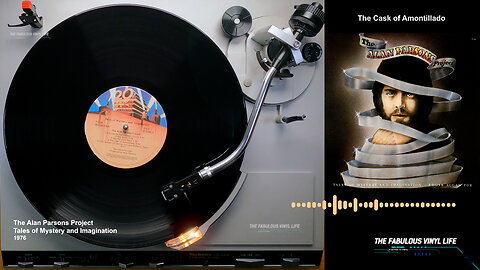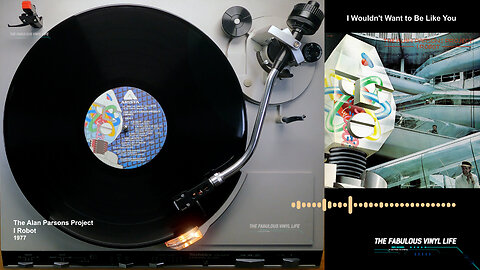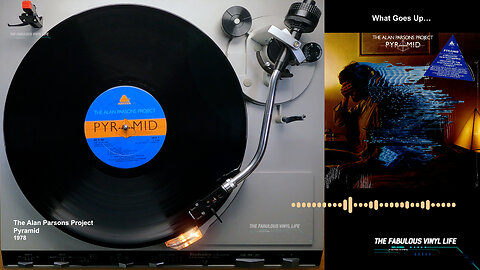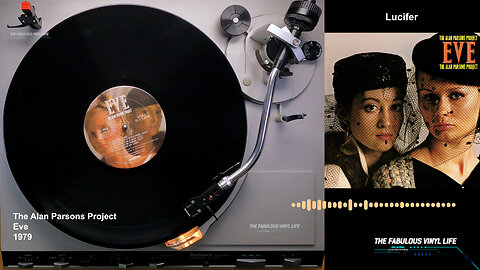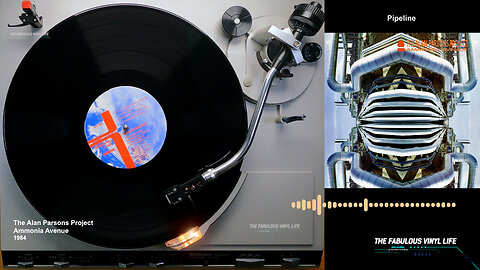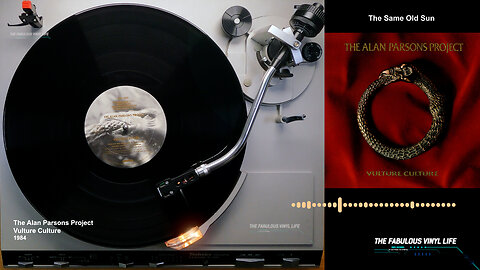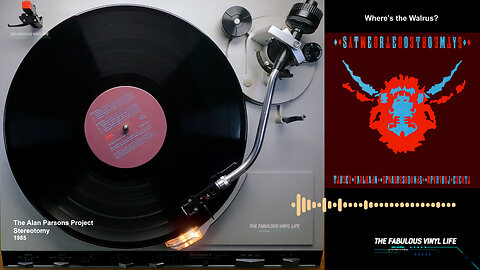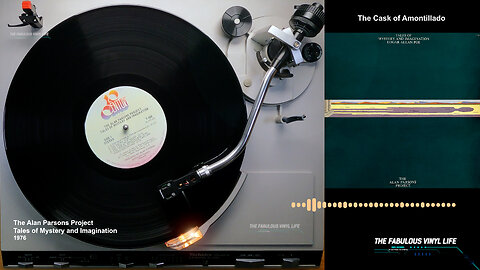
The Alan Parsons Project
9 videos
Updated 6 days ago
The Alan Parsons Project were a British rock band active between 1975 and 1990, whose core membership consisted of producer, audio engineer, musician and composer Alan Parsons and singer, songwriter and pianist Eric Woolfson. They were accompanied by varying session musicians and some relatively consistent session players.
-
The Alan Parsons Project ) Tales of Mystery and Imagination ) 1976 (20th Century US)
 THE FABULOUS VINYL LIFEYou are listening to the genuine Hi-Fi stereo sound transferred from the actual vinyl record in the best possible quality. Tales of Mystery and Imagination (Edgar Allan Poe) is the debut studio album by The Alan Parsons Project. It was released on 25 June 1976 in the UK and Ireland by Charisma Records and 20th Century Records in the rest of the world. The lyrical and musical themes of the album, which are retellings of horror stories and poetry by Edgar Allan Poe, attracted a cult audience. The title of the album is taken from the title of a collection of Poe's macabre stories of the same name. Musicians featured on the album include vocalists Arthur Brown, John Miles, Terry Sylvester and complete line-up of bands Ambrosia and Pilot play, along with keyboardist Francis Monkman. Tales of Mystery and Imagination peaked at No. 38 on Billboard's Pop Albums chart. The song "(The System Of) Doctor Tarr and Professor Fether" peaked at No. 37 on the Pop Singles chart, and No. 62 in Canada. 🔘 Side 1: A Dream Within a Dream The Raven The Tell-Tale Heart The Cask of Amontillado (The System of) Dr. Tarr and Professor Fether 🔘 Side 2: The Fall of the House of Usher - Prelude - Arrival - Intermezzo - Pavane - Fall To One in Paradise87 views 1 comment
THE FABULOUS VINYL LIFEYou are listening to the genuine Hi-Fi stereo sound transferred from the actual vinyl record in the best possible quality. Tales of Mystery and Imagination (Edgar Allan Poe) is the debut studio album by The Alan Parsons Project. It was released on 25 June 1976 in the UK and Ireland by Charisma Records and 20th Century Records in the rest of the world. The lyrical and musical themes of the album, which are retellings of horror stories and poetry by Edgar Allan Poe, attracted a cult audience. The title of the album is taken from the title of a collection of Poe's macabre stories of the same name. Musicians featured on the album include vocalists Arthur Brown, John Miles, Terry Sylvester and complete line-up of bands Ambrosia and Pilot play, along with keyboardist Francis Monkman. Tales of Mystery and Imagination peaked at No. 38 on Billboard's Pop Albums chart. The song "(The System Of) Doctor Tarr and Professor Fether" peaked at No. 37 on the Pop Singles chart, and No. 62 in Canada. 🔘 Side 1: A Dream Within a Dream The Raven The Tell-Tale Heart The Cask of Amontillado (The System of) Dr. Tarr and Professor Fether 🔘 Side 2: The Fall of the House of Usher - Prelude - Arrival - Intermezzo - Pavane - Fall To One in Paradise87 views 1 comment -
The Alan Parsons Project ) Tales of Mystery and Imagination ) 1976 (Alternative cover 20th Century US)
 THE FABULOUS VINYL LIFEYou are listening to the genuine Hi-Fi stereo sound transferred from the actual vinyl record in the best possible quality. Tales of Mystery and Imagination (Edgar Allan Poe) is the debut studio album by The Alan Parsons Project. It was released on 25 June 1976 in the UK and Ireland by Charisma Records and 20th Century Records in the rest of the world. The lyrical and musical themes of the album, which are retellings of horror stories and poetry by Edgar Allan Poe, attracted a cult audience. The title of the album is taken from the title of a collection of Poe's macabre stories of the same name. Musicians featured on the album include vocalists Arthur Brown, John Miles, Terry Sylvester and complete line-up of bands Ambrosia and Pilot play, along with keyboardist Francis Monkman. Tales of Mystery and Imagination peaked at No. 38 on Billboard's Pop Albums chart. The song "(The System Of) Doctor Tarr and Professor Fether" peaked at No. 37 on the Pop Singles chart, and No. 62 in Canada. Alternative cover design & illustration by Clyde Terry. 🔘 Side 1: A Dream Within a Dream The Raven The Tell-Tale Heart The Cask of Amontillado (The System of) Dr. Tarr and Professor Fether 🔘 Side 2: The Fall of the House of Usher - Prelude - Arrival - Intermezzo - Pavane - Fall To One in Paradise113 views 1 comment
THE FABULOUS VINYL LIFEYou are listening to the genuine Hi-Fi stereo sound transferred from the actual vinyl record in the best possible quality. Tales of Mystery and Imagination (Edgar Allan Poe) is the debut studio album by The Alan Parsons Project. It was released on 25 June 1976 in the UK and Ireland by Charisma Records and 20th Century Records in the rest of the world. The lyrical and musical themes of the album, which are retellings of horror stories and poetry by Edgar Allan Poe, attracted a cult audience. The title of the album is taken from the title of a collection of Poe's macabre stories of the same name. Musicians featured on the album include vocalists Arthur Brown, John Miles, Terry Sylvester and complete line-up of bands Ambrosia and Pilot play, along with keyboardist Francis Monkman. Tales of Mystery and Imagination peaked at No. 38 on Billboard's Pop Albums chart. The song "(The System Of) Doctor Tarr and Professor Fether" peaked at No. 37 on the Pop Singles chart, and No. 62 in Canada. Alternative cover design & illustration by Clyde Terry. 🔘 Side 1: A Dream Within a Dream The Raven The Tell-Tale Heart The Cask of Amontillado (The System of) Dr. Tarr and Professor Fether 🔘 Side 2: The Fall of the House of Usher - Prelude - Arrival - Intermezzo - Pavane - Fall To One in Paradise113 views 1 comment -
The Alan Parsons Project ) I Robot ) 1977 (Arista US)
 THE FABULOUS VINYL LIFEYou are listening to the genuine Hi-Fi stereo sound transferred from the actual vinyl record in the best possible quality. I Robot is the 2nd studio album by The Alan Parsons Project, released on 8 July 1977 by Arista Records. Recorded between December 1976 – March 1977 at Abbey Road studios in London. The album was intended to be based on the I, Robot stories written by Asimov, and Eric Woolfson spoke with Asimov himself, who was enthusiastic about the idea. As the rights already had been granted to a TV/movie company, the album's title was altered slightly by removing the comma in "I," and the theme and lyrics were made to be more generically about robots rather than to be specific to the Asimov universe. The cover inlay reads: "I Robot... The story of the rise of the machine and the decline of man, which paradoxically coincided with his discovery of the wheel... and a warning that his brief dominance of this planet will probably end, because man tried to create robot in his own image." The title of the final track, "Genesis CH.1. V.32", follows this theme by implying a continuation to the story of Creation, since the 1st chapter of Genesis only has 31 verses. Paul McCartney unintentionally helped to inspire the song "Some Other Time". When Parsons had asked if McCartney could read a line of poetry for the band's 1st album in exchange for a favor Parsons had previously done him, McCartney replied by saying; "Some other time Alan, some other time". This gave the band an idea for a song title. By pure coincidence, the album was released shortly after Star Wars came out in the United States. The group acknowledges that part of the album's success came from it being the only album with a robot on the cover during a time when robots were suddenly "all the rage". David Paton – bass, acoustic guitar, backing vocals Stuart Tosh – drums, percussion, water gongs Ian Bairnson – electric and acoustic guitars, backing vocals Eric Woolfson – clavinet, Fender Rhodes, Wurlitzer, piano, organ, keyboards, backing vocals Alan Parsons – Projectron, Synthi-A Sequencer Programming, acoustic guitar, vocoder, tape loops and effects, backing vocals Duncan Mackay – keyboards B.J. Cole – steel guitar Andrew Powell – Hammond B-3 organ John Leach – cimbalom and kantele Lenny Zakatek, Allan Clarke, Steve Harley, Jack Harris, Peter Straker, Jaki Whitren, Dave Townsend, the English Chorale, the New Philharmonia Chorus – vocals Hilary Western – soprano vocals Tony Rivers, John Perry and Stu Calver – backing vocals Produced and engineered by Alan Parsons, executive producer Eric Woolfson Orchestra and choir arranged and conducted by Andrew Powell 🔘 Side 1: I Robot I Wouldn't Want to Be Like You Some Other Time Breakdown Don't Let It Show 🔘 Side 2: The Voice Nucleus Day After Day (The Show Must Go On) Total Eclipse Genesis CH.1. V.32135 views 2 comments
THE FABULOUS VINYL LIFEYou are listening to the genuine Hi-Fi stereo sound transferred from the actual vinyl record in the best possible quality. I Robot is the 2nd studio album by The Alan Parsons Project, released on 8 July 1977 by Arista Records. Recorded between December 1976 – March 1977 at Abbey Road studios in London. The album was intended to be based on the I, Robot stories written by Asimov, and Eric Woolfson spoke with Asimov himself, who was enthusiastic about the idea. As the rights already had been granted to a TV/movie company, the album's title was altered slightly by removing the comma in "I," and the theme and lyrics were made to be more generically about robots rather than to be specific to the Asimov universe. The cover inlay reads: "I Robot... The story of the rise of the machine and the decline of man, which paradoxically coincided with his discovery of the wheel... and a warning that his brief dominance of this planet will probably end, because man tried to create robot in his own image." The title of the final track, "Genesis CH.1. V.32", follows this theme by implying a continuation to the story of Creation, since the 1st chapter of Genesis only has 31 verses. Paul McCartney unintentionally helped to inspire the song "Some Other Time". When Parsons had asked if McCartney could read a line of poetry for the band's 1st album in exchange for a favor Parsons had previously done him, McCartney replied by saying; "Some other time Alan, some other time". This gave the band an idea for a song title. By pure coincidence, the album was released shortly after Star Wars came out in the United States. The group acknowledges that part of the album's success came from it being the only album with a robot on the cover during a time when robots were suddenly "all the rage". David Paton – bass, acoustic guitar, backing vocals Stuart Tosh – drums, percussion, water gongs Ian Bairnson – electric and acoustic guitars, backing vocals Eric Woolfson – clavinet, Fender Rhodes, Wurlitzer, piano, organ, keyboards, backing vocals Alan Parsons – Projectron, Synthi-A Sequencer Programming, acoustic guitar, vocoder, tape loops and effects, backing vocals Duncan Mackay – keyboards B.J. Cole – steel guitar Andrew Powell – Hammond B-3 organ John Leach – cimbalom and kantele Lenny Zakatek, Allan Clarke, Steve Harley, Jack Harris, Peter Straker, Jaki Whitren, Dave Townsend, the English Chorale, the New Philharmonia Chorus – vocals Hilary Western – soprano vocals Tony Rivers, John Perry and Stu Calver – backing vocals Produced and engineered by Alan Parsons, executive producer Eric Woolfson Orchestra and choir arranged and conducted by Andrew Powell 🔘 Side 1: I Robot I Wouldn't Want to Be Like You Some Other Time Breakdown Don't Let It Show 🔘 Side 2: The Voice Nucleus Day After Day (The Show Must Go On) Total Eclipse Genesis CH.1. V.32135 views 2 comments -
The Alan Parsons Project ) Pyramid ) 1978 (Arista US)
 THE FABULOUS VINYL LIFEYou are listening to the genuine Hi-Fi stereo sound transferred from the actual vinyl record in the best possible quality. Pyramid (stylized as Pyr△mid) is the 3rd album by The Alan Parsons Project, released in May 1978. Recorded September 1977 – February 1978 at Abbey Road Studios in London. It is a concept album centred on the pyramids of Giza. At the time the album was conceived, interest in pyramid power and Tutankhamun was widespread in the US and the UK. Pyramid was nominated for the 1978 Grammy Award for Best Engineered Album. David Paton – bass, acoustic guitar, vocals Stuart Elliott – drums, percussion Ian Bairnson – electric and acoustic guitars Eric Woolfson – Projectron, Fender Rhodes, clavichord and virginals, piano, organ, backing vocals Duncan Mackay – synthesizers Alan Parsons – Fender Rhodes, acoustic guitar, Wurlitzer, Projectron, backing vocals John Leach – kantele, cimbalom Andrew Powell – autoharp Phil Kenzie – saxophone solos Dean Ford, Colin Blunstone, Lenny Zakatek, John Miles, Jack Harris – vocals Choir: The English Chorale, Choirmaster: Bob Howes Produced and engineered by Alan Parsons 🔘 Side 1: Voyager What Goes Up… The Eagle Will Rise Again One More River Can't Take It with You 🔘 Side 2: In the Lap of the Gods Pyramania Hyper-Gamma-Spaces Shadow of a Lonely Man66 views 3 comments
THE FABULOUS VINYL LIFEYou are listening to the genuine Hi-Fi stereo sound transferred from the actual vinyl record in the best possible quality. Pyramid (stylized as Pyr△mid) is the 3rd album by The Alan Parsons Project, released in May 1978. Recorded September 1977 – February 1978 at Abbey Road Studios in London. It is a concept album centred on the pyramids of Giza. At the time the album was conceived, interest in pyramid power and Tutankhamun was widespread in the US and the UK. Pyramid was nominated for the 1978 Grammy Award for Best Engineered Album. David Paton – bass, acoustic guitar, vocals Stuart Elliott – drums, percussion Ian Bairnson – electric and acoustic guitars Eric Woolfson – Projectron, Fender Rhodes, clavichord and virginals, piano, organ, backing vocals Duncan Mackay – synthesizers Alan Parsons – Fender Rhodes, acoustic guitar, Wurlitzer, Projectron, backing vocals John Leach – kantele, cimbalom Andrew Powell – autoharp Phil Kenzie – saxophone solos Dean Ford, Colin Blunstone, Lenny Zakatek, John Miles, Jack Harris – vocals Choir: The English Chorale, Choirmaster: Bob Howes Produced and engineered by Alan Parsons 🔘 Side 1: Voyager What Goes Up… The Eagle Will Rise Again One More River Can't Take It with You 🔘 Side 2: In the Lap of the Gods Pyramania Hyper-Gamma-Spaces Shadow of a Lonely Man66 views 3 comments -
The Alan Parsons Project ) Eve ) 1979
 THE FABULOUS VINYL LIFEYou are listening to the genuine Hi-Fi stereo sound transferred from the actual vinyl record in the best possible quality. Eve is the 4th studio album by British rock band the Alan Parsons Project, released in September 1979 by Arista Records. The album's focus is on the strength and characteristics of women, and the problems they face in the world of men. It had originally been intended to focus on "great women in history", but evolved into a wider concept. The album name was the same as Eric Woolfson's mother-in-law. Eve is the Alan Parsons Project's first album with singer Chris Rainbow. The album's opening instrumental "Lucifer" was a major hit in Europe, and "Damned If I Do" reached the US Top 40, peaking at No. 27, and reaching No. 16 in Canada. The Alan Parsons Project: Andrew Powell – orchestral arrangements, choral arrangements, conductor David Paton – bass, lead and backing vocals Stuart Elliott – drums, percussion Ian Bairnson – electric and acoustic guitars Eric Woolfson – keyboards, executive producer Duncan Mackay – keyboards Alan Parsons – production, engineering, Morse code Chris Rainbow – lead and backing vocals Lesley Duncan – lead vocal Clare Torry – lead vocal Dave Townsend – lead vocal Lenny Zakatek – lead vocal The Orchestra of the Munich Chamber Opera care of Eberhard Schoener 🔘 Side 1: Lucifer You Lie Down with Dogs I'd Rather Be a Man You Won't Be There Winding Me Up 🔘 Side 2: Damned If I Do Don't Hold Back Secret Garden If I Could Change Your Mind721 views
THE FABULOUS VINYL LIFEYou are listening to the genuine Hi-Fi stereo sound transferred from the actual vinyl record in the best possible quality. Eve is the 4th studio album by British rock band the Alan Parsons Project, released in September 1979 by Arista Records. The album's focus is on the strength and characteristics of women, and the problems they face in the world of men. It had originally been intended to focus on "great women in history", but evolved into a wider concept. The album name was the same as Eric Woolfson's mother-in-law. Eve is the Alan Parsons Project's first album with singer Chris Rainbow. The album's opening instrumental "Lucifer" was a major hit in Europe, and "Damned If I Do" reached the US Top 40, peaking at No. 27, and reaching No. 16 in Canada. The Alan Parsons Project: Andrew Powell – orchestral arrangements, choral arrangements, conductor David Paton – bass, lead and backing vocals Stuart Elliott – drums, percussion Ian Bairnson – electric and acoustic guitars Eric Woolfson – keyboards, executive producer Duncan Mackay – keyboards Alan Parsons – production, engineering, Morse code Chris Rainbow – lead and backing vocals Lesley Duncan – lead vocal Clare Torry – lead vocal Dave Townsend – lead vocal Lenny Zakatek – lead vocal The Orchestra of the Munich Chamber Opera care of Eberhard Schoener 🔘 Side 1: Lucifer You Lie Down with Dogs I'd Rather Be a Man You Won't Be There Winding Me Up 🔘 Side 2: Damned If I Do Don't Hold Back Secret Garden If I Could Change Your Mind721 views -
The Alan Parsons Project ) The Turn of a Friendly Card ) 1980
 THE FABULOUS VINYL LIFEYou are listening to the genuine Hi-Fi stereo sound transferred from the actual vinyl record in the best possible quality. The Turn of a Friendly Card is the fifth studio album by the British progressive rock band The Alan Parsons Project, released in 1980 by Arista Records. The title piece, which appears on side 2 of the LP, is a 16-minute suite broken up into five tracks. The Turn of a Friendly Card spawned the hits "Games People Play" and "Time", the latter of which was Eric Woolfson's first lead vocal appearance. An edited version of the title piece combining the opening and ending parts of the suite was also released as a single along with an official video. As with the band's previous albums, The Turn of a Friendly Card is a concept album with its theme focused on the gambling industry and the fate of gamblers, with more than one reference to Las Vegas (e.g. "there's a sign in the desert that lies to west" from the title piece). Musically it's a more melodic and accessible album than its predecessors. The Alan Parsons Project: Stuart Elliott – drums, percussion David Paton – bass guitar Ian Bairnson – electric, acoustic and classical guitars; pedal steel guitar Eric Woolfson – keyboards, piano, harpsichord, lead vocals Alan Parsons – Projectron, whistling and finger snaps, Clavinet, harpsichord, additional vocals Chris Rainbow – lead and backing vocals Elmer Gantry (Dave Terry) – lead vocal Lenny Zakatek – lead and backing vocals The Philharmonia Orchestra, arranged and conducted by Andrew Powell 🔘 Side One: May Be a Price to Pay Games People Play Time I Don't Wanna Go Home 🔘 Side Two: The Gold Bug The Turn of a Friendly Card i. The Turn of a Friendly Card (Part One) ii. Snake Eyes iii. The Ace of Swords iv. Nothing Left to Lose v. The Turn of a Friendly Card (Part Two)880 views
THE FABULOUS VINYL LIFEYou are listening to the genuine Hi-Fi stereo sound transferred from the actual vinyl record in the best possible quality. The Turn of a Friendly Card is the fifth studio album by the British progressive rock band The Alan Parsons Project, released in 1980 by Arista Records. The title piece, which appears on side 2 of the LP, is a 16-minute suite broken up into five tracks. The Turn of a Friendly Card spawned the hits "Games People Play" and "Time", the latter of which was Eric Woolfson's first lead vocal appearance. An edited version of the title piece combining the opening and ending parts of the suite was also released as a single along with an official video. As with the band's previous albums, The Turn of a Friendly Card is a concept album with its theme focused on the gambling industry and the fate of gamblers, with more than one reference to Las Vegas (e.g. "there's a sign in the desert that lies to west" from the title piece). Musically it's a more melodic and accessible album than its predecessors. The Alan Parsons Project: Stuart Elliott – drums, percussion David Paton – bass guitar Ian Bairnson – electric, acoustic and classical guitars; pedal steel guitar Eric Woolfson – keyboards, piano, harpsichord, lead vocals Alan Parsons – Projectron, whistling and finger snaps, Clavinet, harpsichord, additional vocals Chris Rainbow – lead and backing vocals Elmer Gantry (Dave Terry) – lead vocal Lenny Zakatek – lead and backing vocals The Philharmonia Orchestra, arranged and conducted by Andrew Powell 🔘 Side One: May Be a Price to Pay Games People Play Time I Don't Wanna Go Home 🔘 Side Two: The Gold Bug The Turn of a Friendly Card i. The Turn of a Friendly Card (Part One) ii. Snake Eyes iii. The Ace of Swords iv. Nothing Left to Lose v. The Turn of a Friendly Card (Part Two)880 views -
The Alan Parsons Project ) Ammonia Avenue ) 1984 (Arista US)
 THE FABULOUS VINYL LIFEYou are listening to the genuine Hi-Fi stereo sound transferred from the actual vinyl record in the best possible quality. Ammonia Avenue is the 7th studio album by The Alan Parsons Project, released in February 1984 by Arista Records. "Don't Answer Me" was the album's lead single, and it reached the Top 15 on the US Billboard Hot 100 and the Top 20 in several countries and represents the last big hit for the Alan Parsons Project. Ammonia Avenue is one of the band's biggest-selling albums, carrying Gold certification in the US, Canada, Germany, Netherlands, Platinum in France, and reaching the Top 10 in a number of countries. The title of the album was inspired by Eric Woolfson's visit to Imperial Chemical Industries (ICI) in Billingham, England, where the first thing he saw was a street with miles of pipes, no people, no trees and a sign that read 'Ammonia Avenue', whose portrait was used for the front cover. The album focuses on the possible misunderstanding of industrial scientific developments from a public perspective and a lack of understanding of the public from a scientific perspective. This album was the second of three recorded on analogue equipment and mixed directly to the digital master tape. Ian Bairnson – electric and acoustic guitars Colin Blunstone – vocals Mel Collins – saxophone Stuart Elliott – percussion, drums Alan Parsons – Fairlight programming David Paton – bass Andrew Powell – orchestral arrangements and conducting Chris Rainbow – vocals Eric Woolfson – all keyboards, vocals Lenny Zakatek – vocals Christopher Warren-Green – The Philharmonia Orchestra leader 🔘 Side 1: Prime Time Let Me Go Home One Good Reason Since the Last Goodbye Don't Answer Me 🔘 Side 2: Dancing on a Highwire You Don't Believe Pipeline Ammonia Avenue100 views 2 comments
THE FABULOUS VINYL LIFEYou are listening to the genuine Hi-Fi stereo sound transferred from the actual vinyl record in the best possible quality. Ammonia Avenue is the 7th studio album by The Alan Parsons Project, released in February 1984 by Arista Records. "Don't Answer Me" was the album's lead single, and it reached the Top 15 on the US Billboard Hot 100 and the Top 20 in several countries and represents the last big hit for the Alan Parsons Project. Ammonia Avenue is one of the band's biggest-selling albums, carrying Gold certification in the US, Canada, Germany, Netherlands, Platinum in France, and reaching the Top 10 in a number of countries. The title of the album was inspired by Eric Woolfson's visit to Imperial Chemical Industries (ICI) in Billingham, England, where the first thing he saw was a street with miles of pipes, no people, no trees and a sign that read 'Ammonia Avenue', whose portrait was used for the front cover. The album focuses on the possible misunderstanding of industrial scientific developments from a public perspective and a lack of understanding of the public from a scientific perspective. This album was the second of three recorded on analogue equipment and mixed directly to the digital master tape. Ian Bairnson – electric and acoustic guitars Colin Blunstone – vocals Mel Collins – saxophone Stuart Elliott – percussion, drums Alan Parsons – Fairlight programming David Paton – bass Andrew Powell – orchestral arrangements and conducting Chris Rainbow – vocals Eric Woolfson – all keyboards, vocals Lenny Zakatek – vocals Christopher Warren-Green – The Philharmonia Orchestra leader 🔘 Side 1: Prime Time Let Me Go Home One Good Reason Since the Last Goodbye Don't Answer Me 🔘 Side 2: Dancing on a Highwire You Don't Believe Pipeline Ammonia Avenue100 views 2 comments -
The Alan Parsons Project ) Vulture Culture ) 1984 (Arista US)
 THE FABULOUS VINYL LIFEYou are listening to the genuine Hi-Fi stereo sound transferred from the actual vinyl record in the best possible quality. Vulture Culture is the 8th studio album by The Alan Parsons Project, released in 1984 (early 1985 in some countries) via the Arista label. Recorded and Mixed at Abbey Road Studios, London between May and July 1984. All songs written and composed by Alan Parsons and Eric Woolfson. At the beginning of 1985, the lead single "Let's Talk About Me" reached the Top 40 in Germany (where the album was No. 1), in Switzerland (where Vulture Culture was No. 2) and in the Netherlands. The song features voice-over commentary from Lee Abrams, credited on the album as "Mr. Laser Beam" (an anagram of his name). Originally, the album was intended to be the 2nd LP of a double album, with Ammonia Avenue being the 1st. After the discs were split into separate albums, Vulture Culture was given a more modern (for the time) studio treatment with harder-hitting drums and dynamics. "Sooner or Later" was described by Parsons himself as "the 3rd attempt to try and get another hit with the "Eye in the Sky"-esque chugging guitar line – "Prime Time" from Ammonia Avenue was the 2nd, which I thought was a little more successful in that respect." In the charts, Vulture Culture was a success in continental Europe, often reaching the Top 10, and in Oceania; whereas it was less successful in North America. It was the last album to be certified Gold. The song "Hawkeye" is an instrumental but does contain a line from Monica, a woman working at the canteen in Abbey Road Studios. The line she says is: "Only what's on the menu". This is the only Project album that does not feature the orchestration of Andrew Powell. Vulture Culture was the last Project album recorded on analogue equipment, and as with the previous two, mixed directly to the digital master tape. Ian Bairnson – guitar Colin Blunstone – vocals Richard Cottle – synthesizer, keyboards, saxophone Stuart Elliott – percussion, drums Mr. Laser Beam – vocals, speech/speaker/speaking part Alan Parsons – keyboards, programming, vocals David Paton – bass, vocals Chris Rainbow – vocals Eric Woolfson – piano, keyboards, vocals Lenny Zakatek – vocals 🔘 Side 1: Let's Talk About Me Separate Lives Days Are Numbers (The Traveller) Sooner or Later 🔘 Side 2: Vulture Culture Hawkeye Somebody Out There The Same Old Sun123 views 2 comments
THE FABULOUS VINYL LIFEYou are listening to the genuine Hi-Fi stereo sound transferred from the actual vinyl record in the best possible quality. Vulture Culture is the 8th studio album by The Alan Parsons Project, released in 1984 (early 1985 in some countries) via the Arista label. Recorded and Mixed at Abbey Road Studios, London between May and July 1984. All songs written and composed by Alan Parsons and Eric Woolfson. At the beginning of 1985, the lead single "Let's Talk About Me" reached the Top 40 in Germany (where the album was No. 1), in Switzerland (where Vulture Culture was No. 2) and in the Netherlands. The song features voice-over commentary from Lee Abrams, credited on the album as "Mr. Laser Beam" (an anagram of his name). Originally, the album was intended to be the 2nd LP of a double album, with Ammonia Avenue being the 1st. After the discs were split into separate albums, Vulture Culture was given a more modern (for the time) studio treatment with harder-hitting drums and dynamics. "Sooner or Later" was described by Parsons himself as "the 3rd attempt to try and get another hit with the "Eye in the Sky"-esque chugging guitar line – "Prime Time" from Ammonia Avenue was the 2nd, which I thought was a little more successful in that respect." In the charts, Vulture Culture was a success in continental Europe, often reaching the Top 10, and in Oceania; whereas it was less successful in North America. It was the last album to be certified Gold. The song "Hawkeye" is an instrumental but does contain a line from Monica, a woman working at the canteen in Abbey Road Studios. The line she says is: "Only what's on the menu". This is the only Project album that does not feature the orchestration of Andrew Powell. Vulture Culture was the last Project album recorded on analogue equipment, and as with the previous two, mixed directly to the digital master tape. Ian Bairnson – guitar Colin Blunstone – vocals Richard Cottle – synthesizer, keyboards, saxophone Stuart Elliott – percussion, drums Mr. Laser Beam – vocals, speech/speaker/speaking part Alan Parsons – keyboards, programming, vocals David Paton – bass, vocals Chris Rainbow – vocals Eric Woolfson – piano, keyboards, vocals Lenny Zakatek – vocals 🔘 Side 1: Let's Talk About Me Separate Lives Days Are Numbers (The Traveller) Sooner or Later 🔘 Side 2: Vulture Culture Hawkeye Somebody Out There The Same Old Sun123 views 2 comments -
The Alan Parsons Project ) Stereotomy ) 1985 (Arista US)
 THE FABULOUS VINYL LIFEYou are listening to the genuine Hi-Fi stereo sound transferred from the actual vinyl record in the best possible quality. Stereotomy is the 9th studio album by The Alan Parsons Project, released in December 1985 by Arista Records. The album was recorded and mixed at Mayfair Studios London between October 1984 and August 1985. The orchestra recorded at Abbey Road Studios. The album was recorded entirely on digital equipment. The word "stereotomy" is taken from "The Murders in the Rue Morgue" by Edgar Allan Poe. It refers to the cutting of solid shapes into different forms, and is used as a metaphor for the way that famous people (singers, actors, etc.) are 'shaped' by the demands of fame. The first pressing "stereo" cover with outer red/blue PVC translucent slipcover with inner cardboard cover and lyrics/credits printed on reverse, generic PVC Arista inner sleeve. Eric Woolfson – pianos, keyboards, vocals Alan Parsons – additional keyboards, producer Ian Bairnson – guitars, guitar synth David Paton – bass Stuart Elliott – drums and percussion Richard Cottle – synths and saxes The Philharmonia Orchestra, leader – Christoffer Warren-Green Orchestra arranged and conducted by Andrew Powell Sally Woolfson – voices on "Chinese Whispers" Lorna Woolfson – voices on "Chinese Whispers" Vocals: John Miles, Chris Rainbow, Gary Brooker, Graham Dye, Steven Dye, Eric Woolfson 🔘 Side 1: Stereotomy Beaujolais Urbania Limelight 🔘 Side 2: In the Real World Where's the Walrus? Light of the World Chinese Whispers Stereotomy Two96 views 1 comment
THE FABULOUS VINYL LIFEYou are listening to the genuine Hi-Fi stereo sound transferred from the actual vinyl record in the best possible quality. Stereotomy is the 9th studio album by The Alan Parsons Project, released in December 1985 by Arista Records. The album was recorded and mixed at Mayfair Studios London between October 1984 and August 1985. The orchestra recorded at Abbey Road Studios. The album was recorded entirely on digital equipment. The word "stereotomy" is taken from "The Murders in the Rue Morgue" by Edgar Allan Poe. It refers to the cutting of solid shapes into different forms, and is used as a metaphor for the way that famous people (singers, actors, etc.) are 'shaped' by the demands of fame. The first pressing "stereo" cover with outer red/blue PVC translucent slipcover with inner cardboard cover and lyrics/credits printed on reverse, generic PVC Arista inner sleeve. Eric Woolfson – pianos, keyboards, vocals Alan Parsons – additional keyboards, producer Ian Bairnson – guitars, guitar synth David Paton – bass Stuart Elliott – drums and percussion Richard Cottle – synths and saxes The Philharmonia Orchestra, leader – Christoffer Warren-Green Orchestra arranged and conducted by Andrew Powell Sally Woolfson – voices on "Chinese Whispers" Lorna Woolfson – voices on "Chinese Whispers" Vocals: John Miles, Chris Rainbow, Gary Brooker, Graham Dye, Steven Dye, Eric Woolfson 🔘 Side 1: Stereotomy Beaujolais Urbania Limelight 🔘 Side 2: In the Real World Where's the Walrus? Light of the World Chinese Whispers Stereotomy Two96 views 1 comment
